brake FORD F150 2015 13.G Owners Manual
[x] Cancel search | Manufacturer: FORD, Model Year: 2015, Model line: F150, Model: FORD F150 2015 13.GPages: 549, PDF Size: 5.97 MB
Page 6 of 549
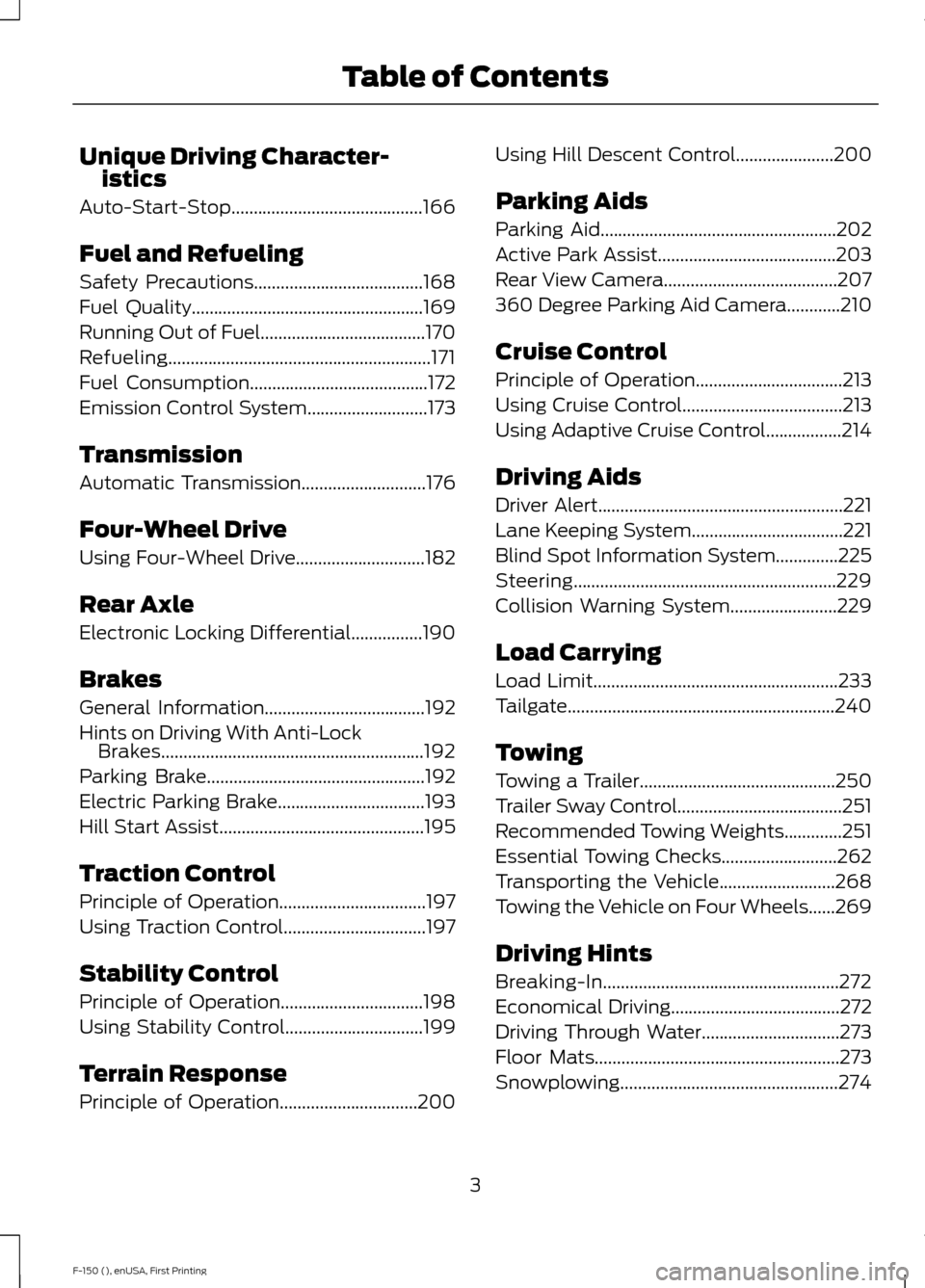
Unique Driving Character-
istics
Auto-Start-Stop...........................................166
Fuel and Refueling
Safety Precautions......................................168
Fuel Quality
....................................................169
Running Out of Fuel.....................................170
Refueling...........................................................171
Fuel Consumption
........................................172
Emission Control System...........................173
Transmission
Automatic Transmission............................176
Four-Wheel Drive
Using Four-Wheel Drive.............................182
Rear Axle
Electronic Locking Differential................190
Brakes
General Information....................................192
Hints on Driving With Anti-Lock Brakes...........................................................192
Parking Brake
.................................................192
Electric Parking Brake
.................................193
Hill Start Assist..............................................195
Traction Control
Principle of Operation.................................197
Using Traction Control................................197
Stability Control
Principle of Operation................................198
Using Stability Control
...............................199
Terrain Response
Principle of Operation...............................200 Using Hill Descent Control......................200
Parking Aids
Parking Aid
.....................................................202
Active Park Assist
........................................203
Rear View Camera.......................................207
360 Degree Parking Aid Camera............210
Cruise Control
Principle of Operation.................................213
Using Cruise Control....................................213
Using Adaptive Cruise Control.................214
Driving Aids
Driver Alert
.......................................................221
Lane Keeping System..................................221
Blind Spot Information System
..............225
Steering...........................................................229
Collision Warning System........................229
Load Carrying
Load Limit
.......................................................233
Tailgate............................................................240
Towing
Towing a Trailer............................................250
Trailer Sway Control
.....................................251
Recommended Towing Weights.............251
Essential Towing Checks..........................262
Transporting the Vehicle
..........................268
Towing the Vehicle on Four Wheels......269
Driving Hints
Breaking-In.....................................................272
Economical Driving
......................................272
Driving Through Water
...............................273
Floor Mats
.......................................................273
Snowplowing.................................................274
3
F-150 (), enUSA, First Printing Table of Contents
Page 7 of 549

Roadside Emergencies
Roadside Assistance...................................277
Hazard Warning Flashers..........................278
Fuel Shutoff
...................................................278
Jump Starting the Vehicle
........................279
Post-Crash Alert System
...........................281
Customer Assistance
Getting the Services You Need...............282
In California (U.S. Only)............................283
The Better Business Bureau (BBB) Auto Line Program (U.S. Only)
.....................284
Utilizing the Mediation/Arbitration Program (Canada Only).......................284
Getting Assistance Outside the U.S. and Canada........................................................285
Ordering Additional Owner's Literature....................................................286
Reporting Safety Defects (U.S. Only)............................................................286
Reporting Safety Defects (Canada Only).............................................................287
Fuses
Fuse Specification Chart..........................288
Changing a Fuse
..........................................296
Maintenance
General Information
...................................297
Opening and Closing the Hood..............297
Under Hood Overview -
2.7L
EcoBoost™...............................................298
Under Hood Overview -
3.5L
Ecoboost™................................................299
Under Hood Overview -
3.5L..................300
Under Hood Overview - 5.0L...................301
Engine Oil Dipstick
......................................302
Engine Oil Check..........................................302
Engine Coolant Check
...............................303
Automatic Transmission Fluid Check...........................................................307 Transfer Case Fluid Check........................307
Brake Fluid Check
.......................................308
Power Steering Fluid Check
....................308
Washer Fluid Check...................................308
Fuel Filter........................................................308
Changing the 12V Battery........................308
Checking the Wiper Blades......................310
Changing the Wiper Blades......................310
Adjusting the Headlamps...........................311
Changing a Bulb
............................................312
Bulb Specification Chart...........................316
Changing the Engine Air Filter.................318
Vehicle Care
General Information
....................................319
Cleaning Products
........................................319
Cleaning the Exterior
...................................319
Waxing.............................................................320
Cleaning the Engine
....................................320
Cleaning the Windows and Wiper Blades...........................................................321
Cleaning the Interior....................................321
Cleaning the Instrument Panel and Instrument Cluster Lens.........................321
Cleaning Leather Seats..............................322
Repairing Minor Paint Damage
...............323
Cleaning the Alloy Wheels.......................323
Vehicle Storage
.............................................324
Wheels and Tires
General Information....................................327
Tire Care
..........................................................329
Using Snow Chains
.....................................344
Tire Pressure Monitoring System..........345
Changing a Road Wheel...........................350
Technical Specifications
...........................358
Capacities and Specific- ations
Engine Specifications................................359
4
F-150 (), enUSA, First Printing Table of Contents
Page 10 of 549
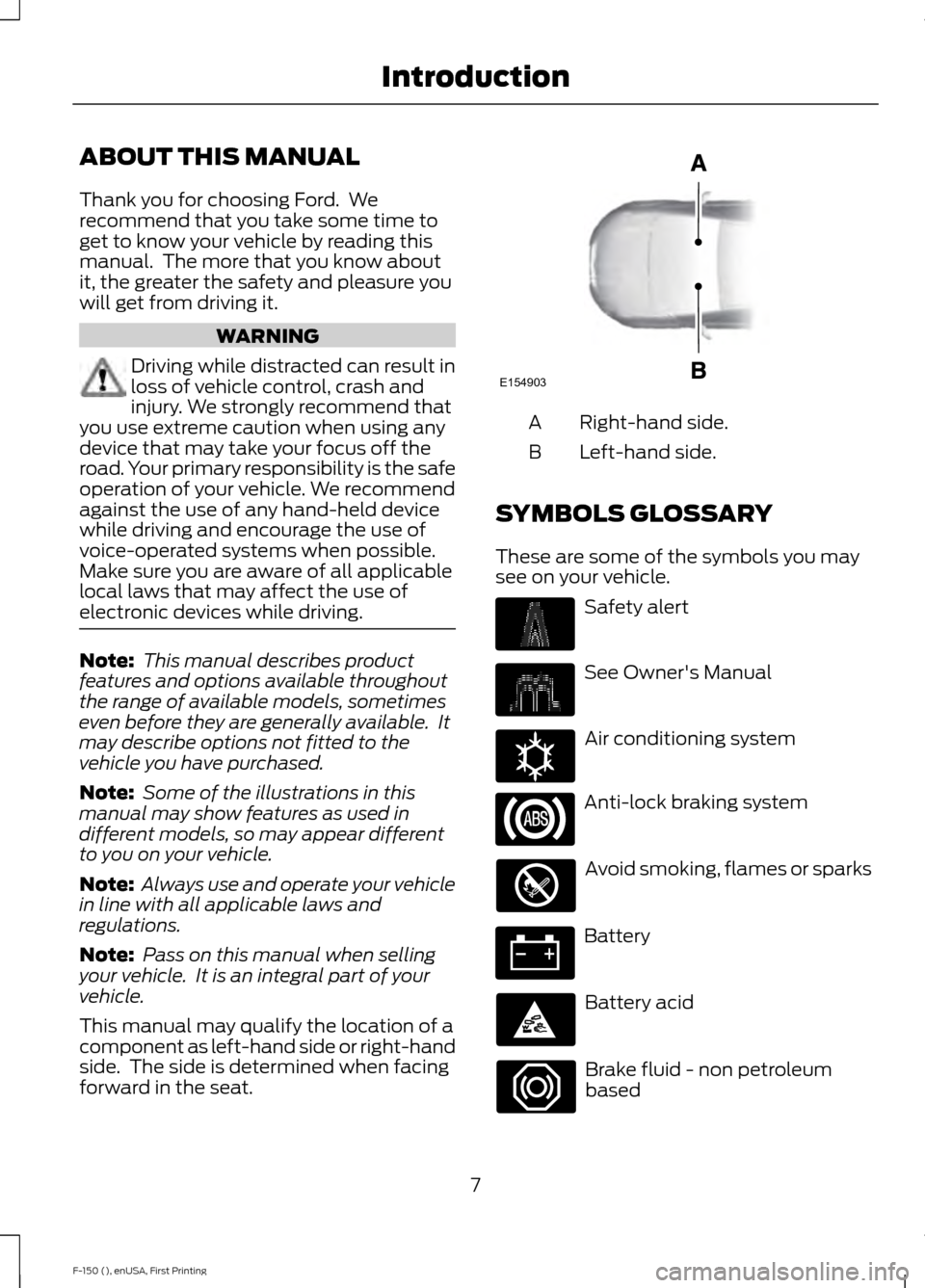
ABOUT THIS MANUAL
Thank you for choosing Ford. We
recommend that you take some time to
get to know your vehicle by reading this
manual. The more that you know about
it, the greater the safety and pleasure you
will get from driving it.
WARNING
Driving while distracted can result in
loss of vehicle control, crash and
injury. We strongly recommend that
you use extreme caution when using any
device that may take your focus off the
road. Your primary responsibility is the safe
operation of your vehicle. We recommend
against the use of any hand-held device
while driving and encourage the use of
voice-operated systems when possible.
Make sure you are aware of all applicable
local laws that may affect the use of
electronic devices while driving. Note:
This manual describes product
features and options available throughout
the range of available models, sometimes
even before they are generally available. It
may describe options not fitted to the
vehicle you have purchased.
Note: Some of the illustrations in this
manual may show features as used in
different models, so may appear different
to you on your vehicle.
Note: Always use and operate your vehicle
in line with all applicable laws and
regulations.
Note: Pass on this manual when selling
your vehicle. It is an integral part of your
vehicle.
This manual may qualify the location of a
component as left-hand side or right-hand
side. The side is determined when facing
forward in the seat. Right-hand side.
A
Left-hand side.
B
SYMBOLS GLOSSARY
These are some of the symbols you may
see on your vehicle. Safety alert
See Owner's Manual
Air conditioning system
Anti-lock braking system
Avoid smoking, flames or sparks
Battery
Battery acid
Brake fluid - non petroleum
based
7
F-150 (), enUSA, First Printing IntroductionE154903 E162384
Page 11 of 549
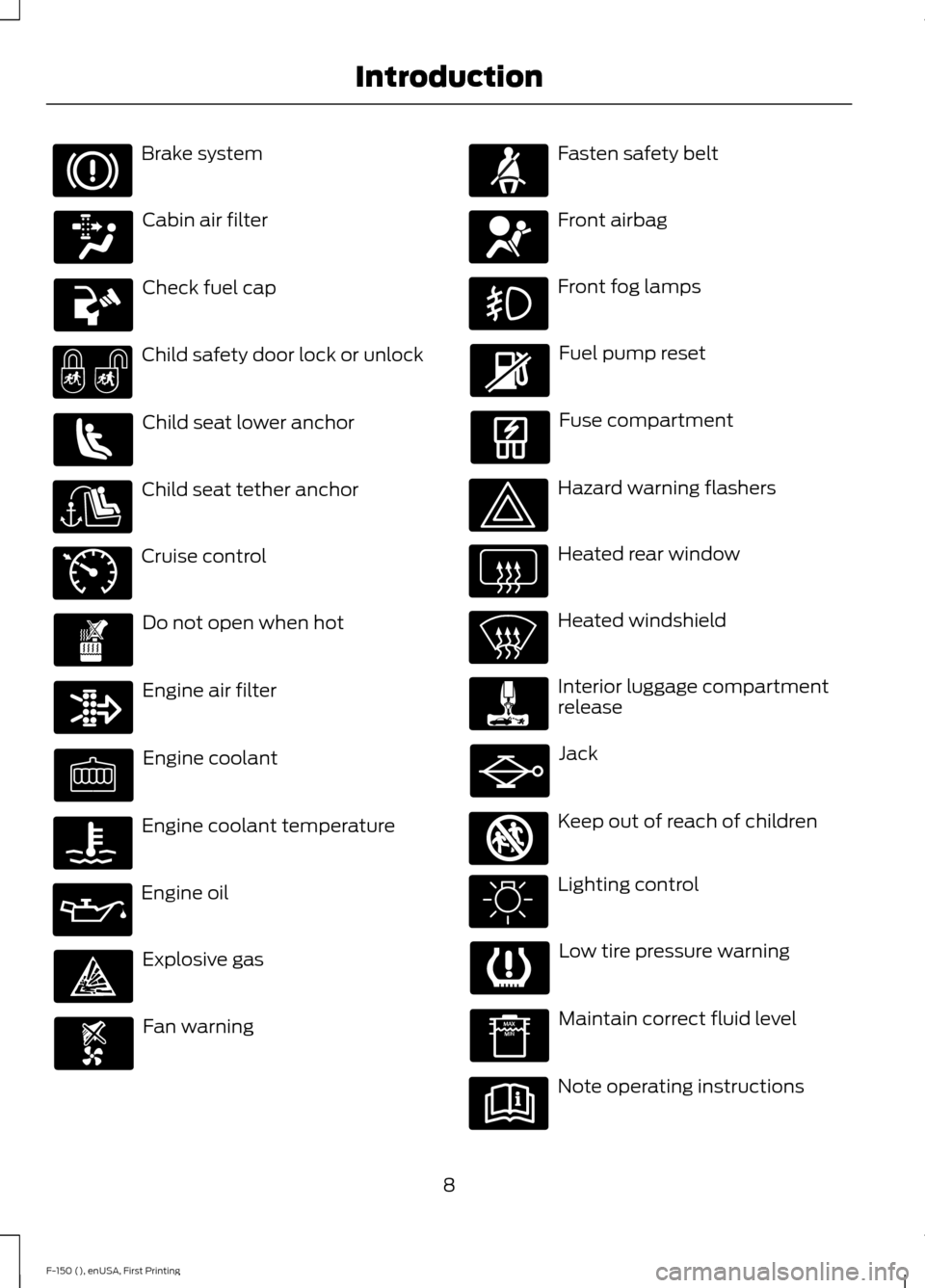
Brake system
Cabin air filter
Check fuel cap
Child safety door lock or unlock
Child seat lower anchor
Child seat tether anchor
Cruise control
Do not open when hot
Engine air filter
Engine coolant
Engine coolant temperature
Engine oil
Explosive gas
Fan warning Fasten safety belt
Front airbag
Front fog lamps
Fuel pump reset
Fuse compartment
Hazard warning flashers
Heated rear window
Heated windshield
Interior luggage compartment
release
Jack
Keep out of reach of children
Lighting control
Low tire pressure warning
Maintain correct fluid level
Note operating instructions
8
F-150 (), enUSA, First Printing Introduction E71340 E161353
Page 12 of 549
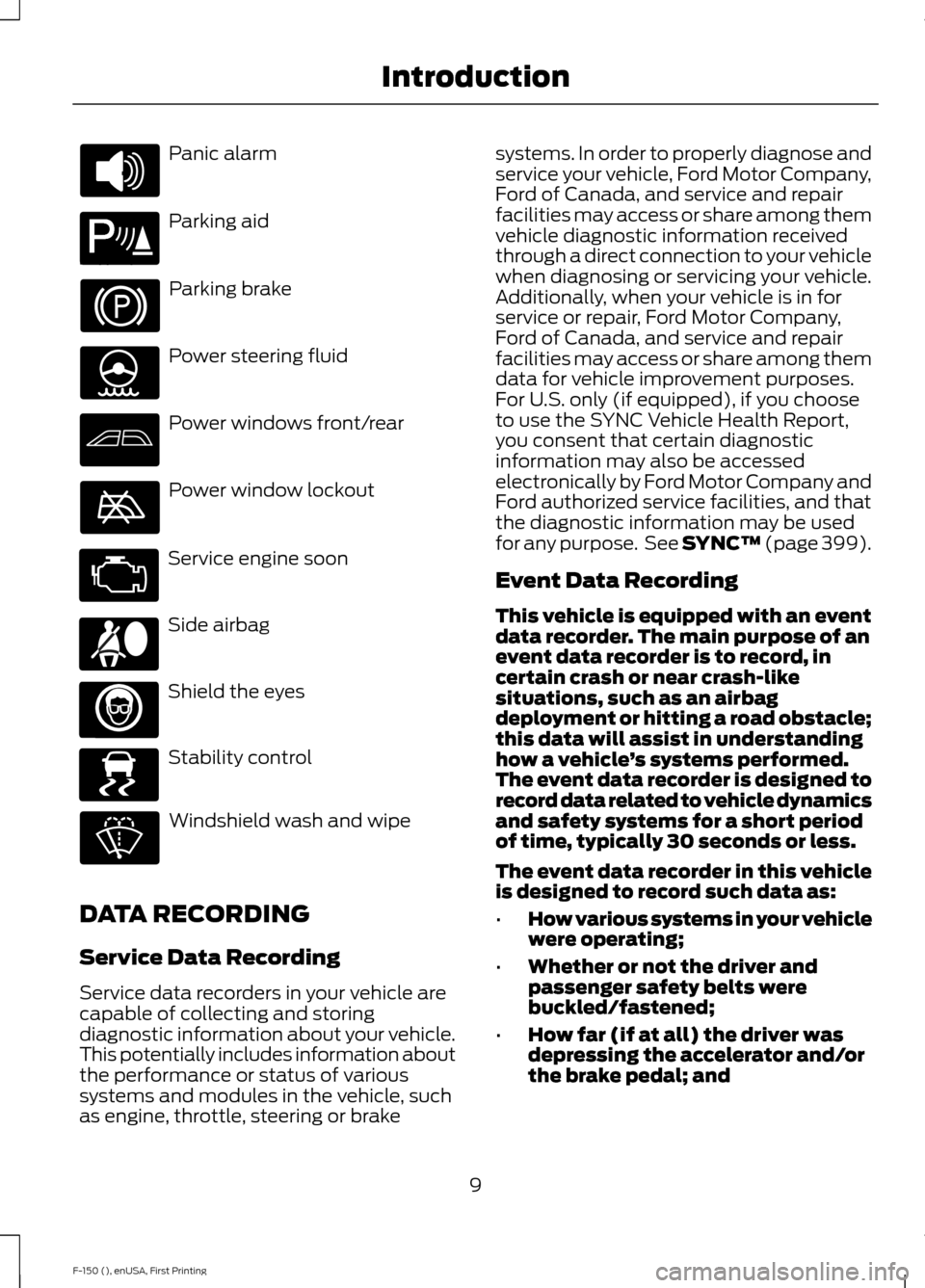
Panic alarm
Parking aid
Parking brake
Power steering fluid
Power windows front/rear
Power window lockout
Service engine soon
Side airbag
Shield the eyes
Stability control
Windshield wash and wipe
DATA RECORDING
Service Data Recording
Service data recorders in your vehicle are
capable of collecting and storing
diagnostic information about your vehicle.
This potentially includes information about
the performance or status of various
systems and modules in the vehicle, such
as engine, throttle, steering or brake systems. In order to properly diagnose and
service your vehicle, Ford Motor Company,
Ford of Canada, and service and repair
facilities may access or share among them
vehicle diagnostic information received
through a direct connection to your vehicle
when diagnosing or servicing your vehicle.
Additionally, when your vehicle is in for
service or repair, Ford Motor Company,
Ford of Canada, and service and repair
facilities may access or share among them
data for vehicle improvement purposes.
For U.S. only (if equipped), if you choose
to use the SYNC Vehicle Health Report,
you consent that certain diagnostic
information may also be accessed
electronically by Ford Motor Company and
Ford authorized service facilities, and that
the diagnostic information may be used
for any purpose. See SYNC™ (page 399).
Event Data Recording
This vehicle is equipped with an event
data recorder. The main purpose of an
event data recorder is to record, in
certain crash or near crash-like
situations, such as an airbag
deployment or hitting a road obstacle;
this data will assist in understanding
how a vehicle
’s systems performed.
The event data recorder is designed to
record data related to vehicle dynamics
and safety systems for a short period
of time, typically 30 seconds or less.
The event data recorder in this vehicle
is designed to record such data as:
• How various systems in your vehicle
were operating;
• Whether or not the driver and
passenger safety belts were
buckled/fastened;
• How far (if at all) the driver was
depressing the accelerator and/or
the brake pedal; and
9
F-150 (), enUSA, First Printing Introduction E139213 E167012 E138639
Page 19 of 549
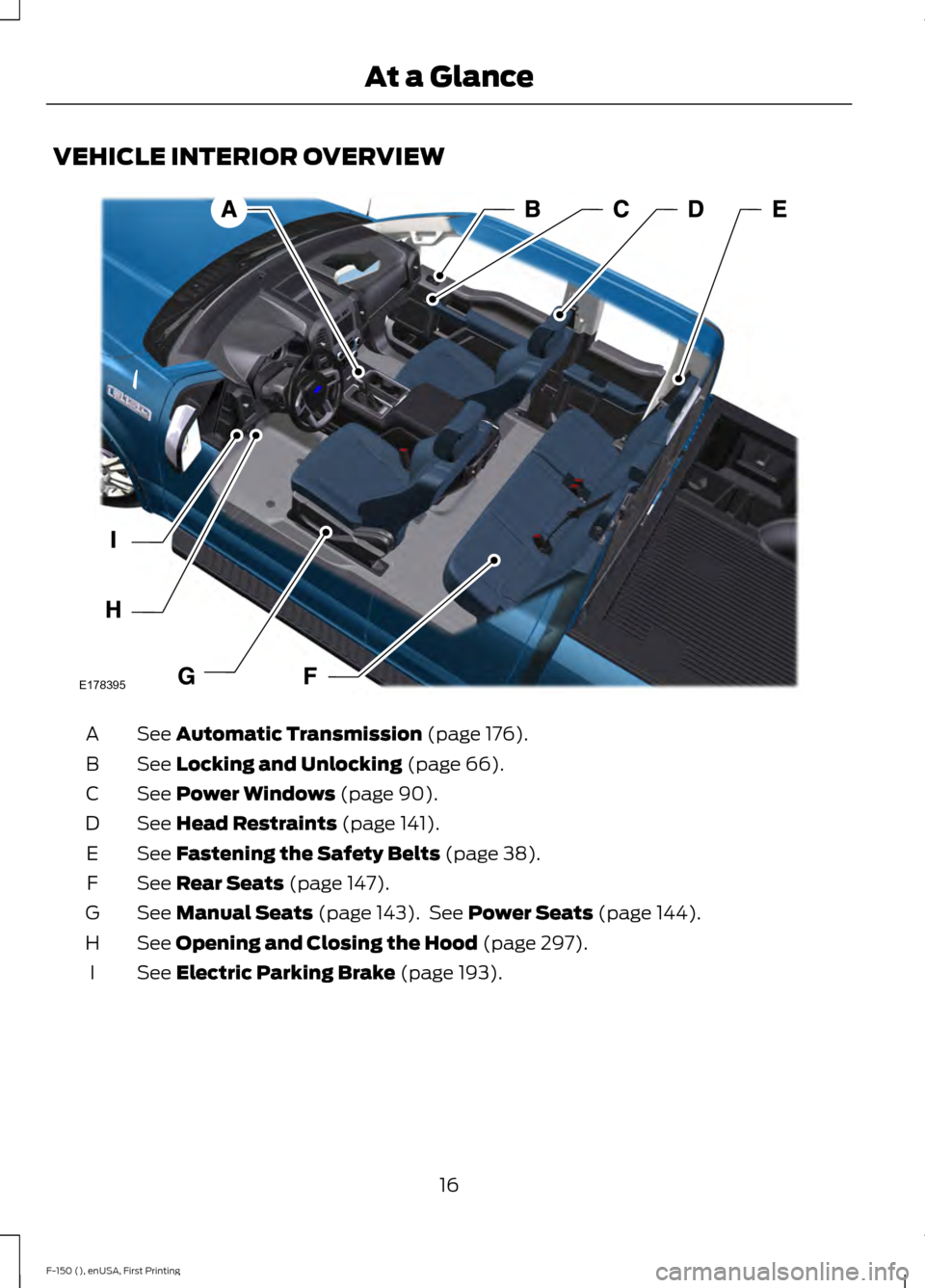
VEHICLE INTERIOR OVERVIEW
See Automatic Transmission (page 176).
A
See
Locking and Unlocking (page 66).
B
See
Power Windows (page 90).
C
See
Head Restraints (page 141).
D
See
Fastening the Safety Belts (page 38).
E
See
Rear Seats (page 147).
F
See
Manual Seats (page 143). See Power Seats (page 144).
G
See
Opening and Closing the Hood (page 297).
H
See
Electric Parking Brake (page 193).
I
16
F-150 (), enUSA, First Printing At a GlanceE178395
Page 20 of 549
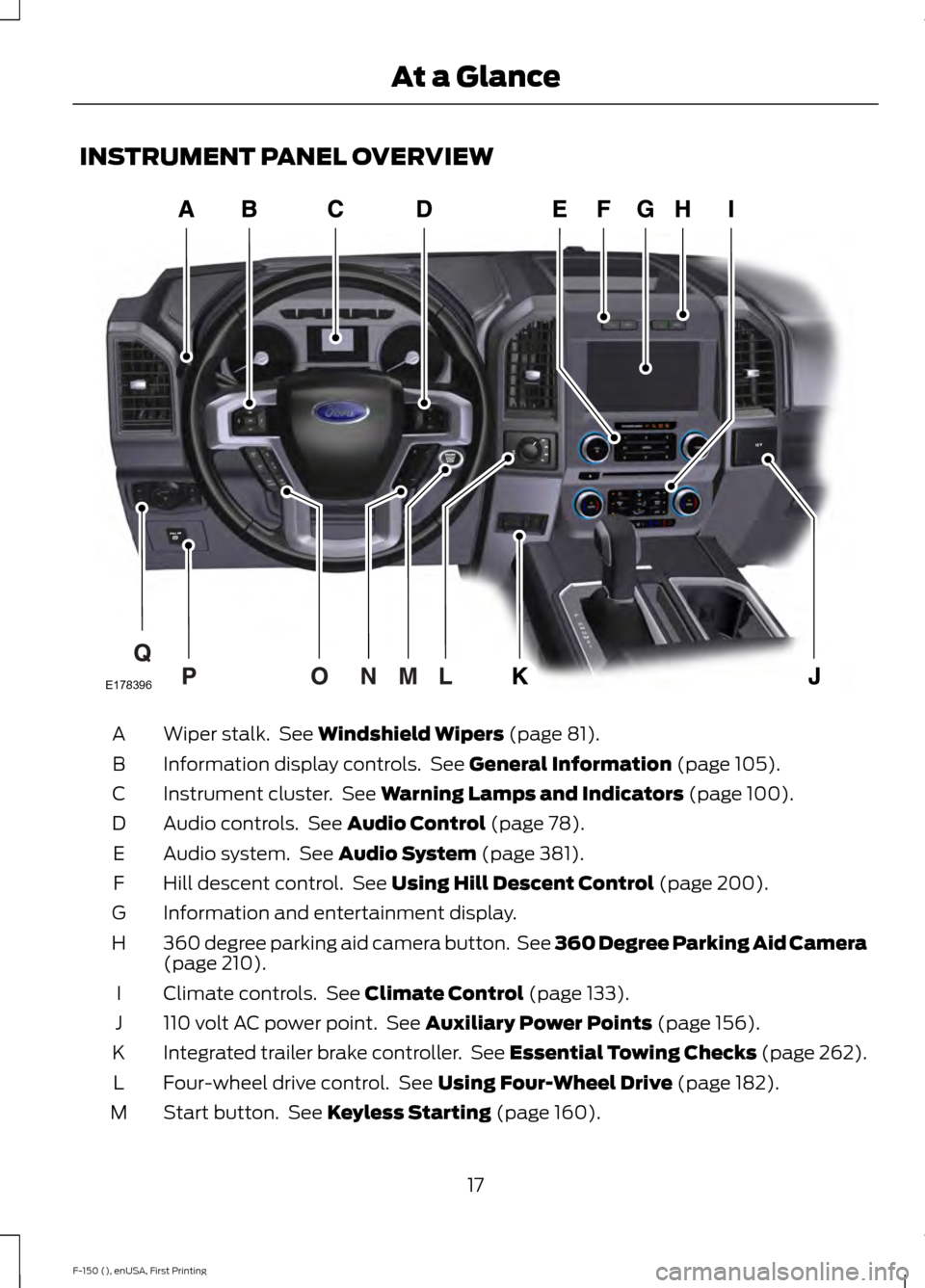
INSTRUMENT PANEL OVERVIEW
Wiper stalk. See Windshield Wipers (page 81).
A
Information display controls. See
General Information (page 105).
B
Instrument cluster. See
Warning Lamps and Indicators (page 100).
C
Audio controls. See
Audio Control (page 78).
D
Audio system. See
Audio System (page 381).
E
Hill descent control. See
Using Hill Descent Control (page 200).
F
Information and entertainment display.
G
360 degree parking aid camera button. See 360 Degree Parking Aid Camera
(page
210).
H
Climate controls. See
Climate Control (page 133).
I
110 volt AC power point. See
Auxiliary Power Points (page 156).
J
Integrated trailer brake controller. See Essential Towing Checks (page 262).
K
Four-wheel drive control. See
Using Four-Wheel Drive (page 182).
L
Start button. See
Keyless Starting (page 160).
M
17
F-150 (), enUSA, First Printing At a GlanceE178396
Page 21 of 549
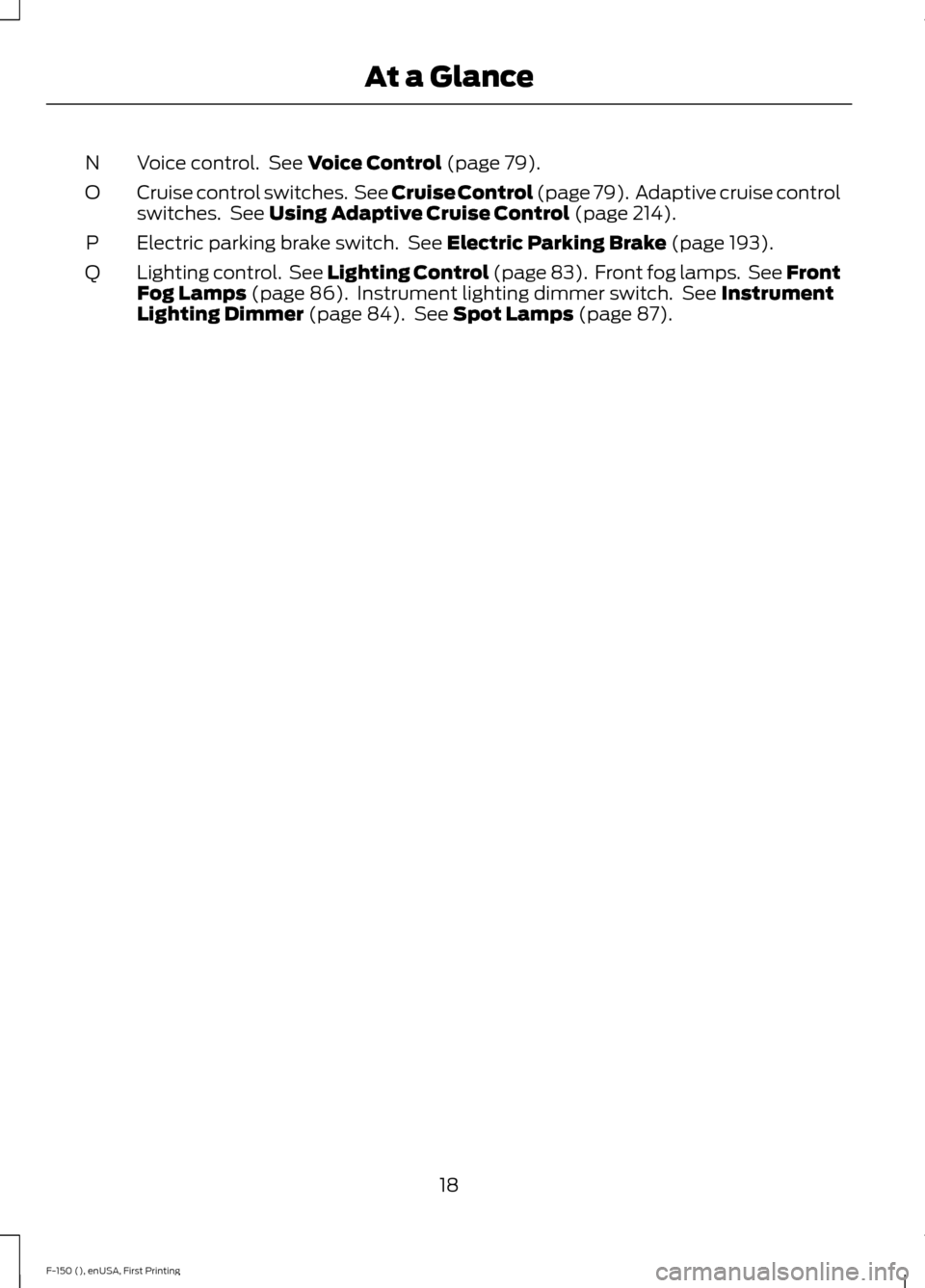
Voice control. See Voice Control (page 79).
N
Cruise control switches. See Cruise Control (page 79). Adaptive cruise control
switches. See
Using Adaptive Cruise Control (page 214).
O
Electric parking brake switch. See
Electric Parking Brake (page 193).
P
Lighting control. See Lighting Control (page 83). Front fog lamps. See Front
Fog Lamps
(page 86). Instrument lighting dimmer switch. See Instrument
Lighting Dimmer (page 84). See Spot Lamps (page 87).
Q
18
F-150 (), enUSA, First Printing At a Glance
Page 42 of 549

1. To lengthen the lap belt, pull some
webbing out of the shoulder belt
retractor.
2. While holding the webbing below the tongue, grasp the tip (metal portion)
of the tongue so that it is parallel to the
webbing and slide the tongue upward.
3. Provide enough lap belt length so that
the tongue can reach the buckle.
Fastening the Cinch Tongue WARNING
The lap belt should fit snugly and as
low as possible around the hips, not
across the waist.
1.
Pull the lap and shoulder belt from the
retractor so that the shoulder belt
portion of the safety belt crosses your
shoulder and chest.
2. Be sure the belt is not twisted. If the belt is twisted, remove the twist.
3. Insert the belt tongue into the proper buckle for your seating position until
you hear a snap and feel it latch.
4. Make sure you securely fasten the tongue to the buckle by pulling on the
tongue.
While you are fastened in the safety belt,
the lap and shoulder belt with a cinch
tongue adjusts to your movement.
However, if you brake hard, turn hard, or if
your vehicle receives an impact of 5 mph
(8 km/h) or more, the safety belt will
become locked and help reduce your
forward movement. Using Safety Belts During
Pregnancy WARNING
Always ride and drive with your
seatback upright and the safety belt
properly fastened. The lap portion of
the safety belt should fit snug and be
positioned low across the hips. The
shoulder portion of the safety belt should
be positioned across the chest. Pregnant
women should also follow this practice. Pregnant women should always wear their
safety belt. Position the lap belt portion of
a combination lap and shoulder belt low
across the hips below the belly and worn
as tight as comfort will allow. Position the
shoulder belt to cross the middle of the
shoulder and the center of the chest.
Safety Belt Locking Modes
WARNINGS
After any vehicle crash, the safety
belt system at all passenger seating
positions must be checked by an
authorized dealer to verify that the
automatic locking retractor feature for
child seats is still functioning properly. In
addition, all safety belts should be checked
for proper function.
39
F-150 (), enUSA, First Printing Safety BeltsE142590
Page 43 of 549

WARNINGS
The belt and retractor must be
replaced if the safety belt assembly
automatic locking retractor feature
or any other safety belt function is not
operating properly when checked by an
authorized dealer. Failure to replace the
belt and retractor assembly could increase
the risk of injury in crashes. All safety restraints in the vehicle are
combination lap and shoulder belts. The
driver safety belt has the first type of
locking mode, and the front outboard
passenger and rear seat safety belts have
both types of locking modes described as
follows:
Vehicle Sensitive Mode
This is the normal retractor mode, which
allows free shoulder belt length
adjustment to your movements and
locking in response to vehicle movement.
For example, if the driver brakes suddenly,
turns a corner sharply, or the vehicle
receives an impact of about 5 mph
(8 km/h) or more, the combination safety
belts will lock to help reduce forward
movement of the driver and passengers.
In addition, the retractor is designed to lock
if the webbing is pulled out too quickly. If
this occurs, let the belt retract slightly and
pull webbing out again in a slow and
controlled manner.
Automatic Locking Mode
In this mode, the shoulder belt is
automatically pre-locked. The belt will still
retract to remove any slack in the shoulder
belt. The automatic locking mode is not
available on the driver safety belt. When to Use the Automatic Locking
Mode
Use this mode any time you install a child
safety seat in a front outboard passenger
seating position in a Regular Cab,
SuperCab, SuperCrew or any rear seating
position of a SuperCab or SuperCrew. The
optional front seat's center safety belt has
a cinch mechanism. Children 12 years old
and under should be properly restrained in
a rear seat whenever possible. See
Child
Safety (page 19).
How to Use the Automatic Locking
Mode
Non-inflatable safety belts 1. Buckle the combination lap and
shoulder belt.
2. Grasp the shoulder portion and pull downward until you pull the entire belt
out.
3. Allow the belt to retract. As the belt retracts, you will hear a clicking sound.
This indicates the safety belt is now in
the automatic locking mode.
40
F-150 (), enUSA, First Printing Safety BeltsE142591